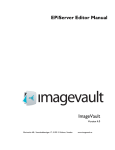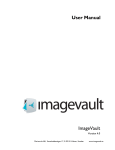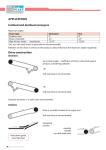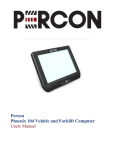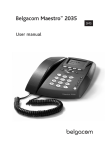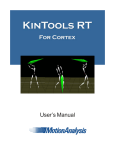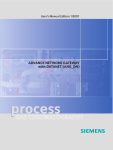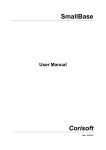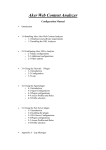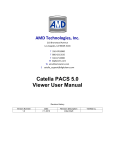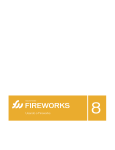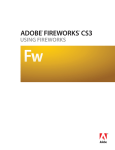Download EPiServer Editor Manual ImageVault
Transcript
EPiServer Editor Manual ImageVault Version 4.0 Meriworks AB, Svensknabbevägen 17, S-393 51 Kalmar, Sweden www.imagevault.se ImageVault | Editor Manual Copyright This manual is protected by international copyright law. No changes of content or reproduction of parts of this publication are allowed without permission from the publisher. EPiServer Editor Manual version 4.0 Created November 4, 2012 Last edited November 20, 2015 © Meriworks AB ImageVault | Editor Manual Contents 1. 1.1. 1.2. 1.3. 1.4. 1.5. Introduction .............................................................................. 5 Prerequisites .................................................................................................. 5 Manual conventions ..................................................................................... 5 Manual instructions ...................................................................................... 5 Relation to other manuals .......................................................................... 5 What’s new? .................................................................................................. 6 2. 2.1. Start ........................................................................................... 7 ImageVault functionality .............................................................................. 7 2.1.1. 2.1.2. 2.1.3. Vaults .......................................................................................................................... 7 Categories.................................................................................................................. 7 Metadata ..................................................................................................................... 7 2.2. Starting mode ................................................................................................ 8 3. 3.1. Insert media files from ImageVault ....................................... 9 Add images to the text editor field .......................................................... 9 3.1.1. Image editor ........................................................................................................... 11 4. 4.1. 4.2. ImageVault page properties.................................................. 14 Media property ........................................................................................... 14 Media list property ..................................................................................... 15 4.3. EPiServer 7 CMS Gadget .......................................................................... 18 5. Administer Media or Medialist page properties ................. 19 6. 6.1. Interface ................................................................................... 22 Interface overview ...................................................................................... 22 6.1.1. 6.1.2. 6.1.3. 6.1.4. Categories............................................................................................................... 23 Vault selection ....................................................................................................... 24 File preview ............................................................................................................ 25 File information and metadata ............................................................................ 25 7. 7.1. 7.2. Importing files ......................................................................... 27 Upload........................................................................................................... 27 Organizing files ............................................................................................ 28 7.2.1. 7.2.2. Altering file information....................................................................................... 31 Move a file to a new vault ................................................................................... 31 7.3. File deletion ................................................................................................. 32 8. Search ...................................................................................... 33 4.2.1. 4.2.2. 4.2.3. ©Meriworks AB Batch insert images into a Medialist .................................................................. 16 Rearrange Medialist images ................................................................................. 16 Edit images in a Media or Medialist object ...................................................... 17 3 ImageVault | Editor Manual 8.1. 8.2. 8.3. Free text search .......................................................................................... 33 Category search .......................................................................................... 33 Search scope ................................................................................................ 34 9. 9.1. File download .......................................................................... 35 Download & conversion ........................................................................... 35 10. 10.1. 10.2. 10.3. 10.4. Share files ................................................................................ 36 Create share ................................................................................................ 36 View shared files ......................................................................................... 37 Managing shared files ................................................................................. 38 Remove share.............................................................................................. 40 11. 11.1. 11.2. 11.3. 11.4. Batch operations .................................................................... 41 Adding files to a batch ............................................................................... 41 Organize files ............................................................................................... 42 Move files ..................................................................................................... 42 Clear batch .................................................................................................. 43 12. 12.1. 12.2. Advanced settings................................................................... 44 Global rights ................................................................................................ 45 Metadata definitions ................................................................................... 46 12.3. 12.4. Media formats ............................................................................................. 48 Categories .................................................................................................... 51 11.4.1. Download files ....................................................................................................... 43 12.2.1. Add mapping .......................................................................................................... 47 12.4.1. Rename or delete a category ............................................................................. 51 12.4.2. Add main or sub level category ......................................................................... 52 12.4.3. Add a category from the main user interface ................................................. 52 13. 13.1. 13.2. Vault administration .............................................................. 54 Add vault ...................................................................................................... 54 Modify Vault ................................................................................................. 56 14. 14.1. Authentication ........................................................................ 58 Signing out from ImageVault .................................................................... 58 ©Meriworks AB 4 ImageVault | Editor Manual 1. Introduction Welcome! ImageVault is a web based file repository, which simplifies handling and storing of media files. The basic function of ImageVault is to store files on a central server, so everyone in an organisation can access, and use the files. ImageVault has sofisticated search and categorization of files which greatly simplifies finding and using media files. ImageVault could complement or replaces the built in image function in EPiServer. 1.1. Prerequisites ImageVault is based on common web standards and is very intuitive and easy to use. Basic internet browser skills are recommended. EPiServer page editing skills and basic page administration is needed. 1.2. Manual conventions Certain typographic conventions are used in this manual. Running text is presented in the Gill Sans font. Notes, tips and warnings are presented in bold. Note! A note highlights important information. Tip! A tip contains an advice or an easier way to do something. Warning! A warning highlights that a problem that might occur and how to avoid it. 1.3. Manual instructions The manual has the following recommended reading order: First time users should start to read chapters number 2 and 6 which cover startup and the ImageVault user interface. Chapters 3, 4, 7, 8, 9 and 10, describes the most common processes in ImageVault, like file upload, file insert, download and batch operations. More advanced users can continue to read chapters 5, 11, 12 and 13 which contain information about administrative tasks. 1.4. Relation to other manuals This manual, ImageVault: Editor manual, is aimed towards an editor in EPiServer. The ImageVault: User manual is aimed towards users of the standalone version. Documentation aimed towards installation and development is only available online. The online documentation for ImageVault can be found online at http://www.imagevault.se. ©Meriworks AB 5 ImageVault | Editor Manual 1.5. What’s new? Imagevault 4.0 is redesigned from the ground up. Several functions have been added or reworked to simplify the usage. The following functions have been added. New UI A brand new user interface makes navigation easier and simplifies file organization. Fast navigation It’s is now possible to quickly browse pictures by using categories, free text search or vaults. Stand alone or CMS ImageVault can now be used either as a stand-alone program or in conjunction with a CMS solution like EPiServer. Batch handling Large volumes of files can be processed at once, i.e. converting files or adding metadata to files. Extensive API ImageVault functionality can easily be extended by third party plug-ins. Refer to http://www.imagevault.se for up to date information about news, upgrades and plug-in availability. ©Meriworks AB 6 ImageVault | Editor Manual 2. Start To be able to use ImageVault an account in EPiServer with editing permissions is needed. Basic knowledge of page creation and editing in EPiServer is also needed. More information on page creation and editing can be found in the EPiServer Editor’s Manual. 2.1. ImageVault functionality ImageVault acts as a central repository for files. All editors have access to this repository during page creation and editing. It also helps the editors to build a structured environment for the files with with storage vaults, metadata and category tagging to facilitate easy search and access. The files only needs to be stored once and are linked to each page where they are used. ImageVault also helps in maintaining site rules, since several standard media formats can be easily set up. Images taken straight of a high resolution digital camera can be used and image conversion and size altering are applied to convert the image to a format that complies with the page layout and site rules. ImageVault helps file categorization by allowing users to add properties to the uploaded files. This is metadata in the form of categories and metadata fields which makes it much easier for other users to find and use the uploaded files. User access is controlled by vaults. Below follows a short explanation of some of the key features in ImageVault 4.0. 2.1.1. Vaults A vault is a storage area in ImageVault, with user rights similar to a file folder. Different types of user access control can be added to a vault, i.e to prevent accidental deletion of files or simply to restrict access to certain files. A vault cannot have sub levels. Different metadata definitions can be tailored for each vault. 2.1.2. Categories Categories are predefined file properties that will facilitate easier search for files. The number of categories is unlimited, but a limited number should be added or created during setup. Sub categories can be added, but a maximum of 2 levels below the top level. 2.1.3. Metadata Metadata are additional information fields that can be added to files. This can for example be the name of the photographer or an additional description of the file. Metadata can also be information stored in a file like ITPC or EXIF data. ©Meriworks AB 7 ImageVault | Editor Manual 2.2. Starting mode Editing Mode in EPiServer is used to create and edit pages. Image Vault is available during editing. EPiServer in edit mode To access the ImageVault UI use the link in the top menu. ImageVault onlinecenter The user interface is described more thoroughly in chapter 6 “Interface”. ©Meriworks AB 8 ImageVault | Editor Manual 3. Insert media files from ImageVault ImageVault is integrated in EPiServer and is used instead of the ordinary EPiServer image handling function. Image Vault also offers several new page properties for display of images. ImageVault can be used to publish media files in either a normal text editor field or the EPiServer page properties Media or Medialist. The visual apperance on a page, of the Media and Medialist page properties, will differ greatly between installations due to EPiServers high degree of configurability. The method for adding or modifying the media files will however be the identical to the description below. 3.1. Add images to the text editor field The text editor field is a common text field which can hold both text and images. ImageVault replaces the built in media file insert method found in EPiServer. Use the insert button to insert media files: Insert with ImageVault . Insert with ImageVault ©Meriworks AB 9 ImageVault | Editor Manual This will open the ImageVault user interface. ImageVault user interface The user interface is described more thoroughly in chapter 6 “Interface”. Select an media file and press the button Insert. The system will present the user with a number of predefined media formats. A media format can be setup to both resize an image and also to convert the image file format. Image conversion formats The image will be placed on the page. The image size can be altered after the insert. Use the image editor described in the next section. Note! Avoid resizing the image using the image resize handles within the text field. This might distort the image and will not alter the image size. Use the ImageVault image editor instead. ©Meriworks AB 10 ImageVault | Editor Manual 3.1.1. Image editor The image editor can be started by selecting an inserted image and pressing the edit button found in the text field menu . Edit button ©Meriworks AB 11 ImageVault | Editor Manual Image editor Size settings fields Zoom slider Crop area When the editor is opened, the image is shown zoomed- and cropped according to previous operations (if any). Use the zoom slider to zoom in or out. It is also possible to use the mouse scrollwhell to zoom. Move the image around by clicking and moving the mouse. The image can be adjusted on a pixel by pixel basis using the arrow keys to pan up/down or left/right, if precise adjustment is needed. The width and height can be modified either by using the size settings fields. Initially the crop area has a locked aspect ratio, so if you modify the width- or height, the aspect ratio will be maintained. In order to define the crop area freely, you will have to unlock the aspect ratio by clicking the blue link-icon in the size setting field. ©Meriworks AB 12 ImageVault | Editor Manual When the aspect ratio of the crop area is unlocked, you may modify the crop area by dragging the resize handles. With aspect ratio unlocked, the link-icon is greyed out. You may lock the aspect ratio at any time by clicking the link-icon again and the new aspect ratio will be maintained. Press the Ok button to commit the change or cancel to abort. The top right x will also abort the edit. ©Meriworks AB 13 ImageVault | Editor Manual 4. ImageVault page properties Image Vault adds two new types of page properties; Media and Medialist. 4.1. Media property The Media property is an EPiServer page object that can be added to a page and can be used to select etiher an image or a movie. Press the plus sign or press Insert new file to add a media file. This will open the ImageVault user interface. Locate and select the file in ImageVault. Selection can be performed with single click on a media file. Press Insert to add the file. Insert button Selected image Insert image The file can be removed by pressing Remove file. Insert file Edit file Remove file Media property ©Meriworks AB 14 ImageVault | Editor Manual 4.2. Media list property The Medialist property is an EpiServer page object that can be added to a page and can be used to select single or multiple images. The Medialist object is typically used for an image gallery or a list of files. Press the plus sign or Insert new files to add a single or multiple image files. Locate the image in ImageVault and press Insert to add the media file. Insert button Selected image Insert image Insert file Remove all files Media list property ©Meriworks AB 15 ImageVault | Editor Manual 4.2.1. Batch insert images into a Medialist It is possible to insert multiple images into a Medialist by using the batch function in ImageVault. Press the plus sign to open ImageVault. Select multiple images by checking the tick box on each image. Selection tick box Batch area Batch insert Batch insert The selected images are collected in the batch area. Press the batch insert button. All selected images are added to the Medialist page property. 4.2.2. Rearrange Medialist images The images in the Medialist can be rearranged by simple drag and drop. Press and hold an image and drop it to a new location. The sort order is from left to right where the leftmost image will be the first image in the Media list. Rearrange Medialist images Images can be removed either by pressing Remove all images, which will delete all images in the Mediallist, or by pressing the X on individual images. ©Meriworks AB 16 Remove image ImageVault | Editor Manual Remove image 4.2.3. Edit images in a Media or Medialist object Images in a Media or Medialist object can be modified in size in a similar way as in the text editor. Press the edit symbol on the image. Edit image Edit image This opens the image editor. Image editor The image can be modified in the same way that is described in the text field editor found previously in this chapter, se section 3.1.1 “Image editor”. Note! The Media and Medialist page properties have settings that under certain conditions will prevent a user from resizing the image using the size setting fields. More information about this can be found in next section that handles administration. ©Meriworks AB 17 ImageVault | Editor Manual 4.2.4. Edit images in a Media or Medialist object For a video in a Media or Medialist object can start/stop be modified to create a clip containing a part of actual video before publich. Press the edit symbol to initiate the editor. Adjust finely, in second level Adjustment Preview Grep the slider and adjust start and stop value until right part of actual video clip is choosen. Adjust finely via clicking on arrows for start/stop. It’s possible to look into clip via preivew slider. Numeric is start, stop, clip length and original leght presented in seconds. When ready, press OK and edited clip will create and convert one new video, see chapter 7.1.1. Note! Create new video could take some time, based on size and performance. Tip! Preview before publich to secure that new video is ready. 4.3. EPiServer 7 CMS Gadget In addition to the above it is also possible in EPiServer 7 CMS to use the ImageVault Media Gadget to find and select files. Open up the asset pane and use the ImageVault Media Gadget to search for the files to be published. The gadget will offer search based on a combination off categories and text. Select the files to publish and simply drag and drop it to the desired Media property. ©Meriworks AB 18 ImageVault | Editor Manual Drag and drop file to Media Property 5. Administer Media or Medialist page properties The Media and Medialist page properties have administrative settings which controls how an image can be edited and how it will be published. Navigate to Admin mode and Page Type settings. Administration mode Note! Not all users have access to the administrative settings. ©Meriworks AB 19 ImageVault | Editor Manual Select which page to change settings for. The different page elements that the page consists of are displayed in a list. Setting links Page properties list Press the settings link to administer a page property. This will open the Edit Property page. Activate the Custom Settings tab. Custom settings Values in the width and height settings will lock the image size to this specific value. A filled out value will restrict the editor from changing the value in the image editor, whereas a blank field will permit the editor to change the value. ©Meriworks AB 20 ImageVault | Editor Manual The resize mode is either Scale to fit or Scale to fill. See example below. The image in the example is 600 pixels wide and 400 pixels in height, and has an aspect ratio of 1.5:1. 600 px 400 px The examples show an image where the width and height settings are both set to 300 pixels. 300 px 300 px Scale to fit The image will be scaled to fit within the given width and height boundaries. 300 px 300 px Scale to fill The image will be scaled in such a way that it will fill the entire are. This will in most cases lead to some degree of image cropping. 300 px 300 px The image will be scaled to a suitable format based on the width and height aspect ratio. Both height and width values must be specified. A developer can override the settings set in admin mode when creating the page template. The size settings will however still be used while editing the image. ©Meriworks AB 21 ImageVault | Editor Manual 6. Interface The ImageVault user interface consists of 6 main areas, see picture below. Import, insert, search and setting Settings Category and library Batch operation File display Information/ Metadata Main user interface 6.1. Interface overview File display area All available files are displayed as preview thumbnails in the file display area. The number of visible files will depend on current vault content, current user access rights, search results or category selections. Import, insert, search and setting area Use the buttons to import, download, move and categorize files. The search bar will filter which files that are displayed based on a free text search. The insert button will insert files into a cms. The button is only active if ImageVault is connected to a cms. Category and library area The categories section displays all available categories in the system. Selecting a category will filter which files that are displayed. The library section displays all vaults available on the server. All vaults might not be visible to all users thanks to user access rights. ©Meriworks AB 22 ImageVault | Editor Manual Batch operation area The batch area collects selections of files. It is possible to perform category or metadata batch operations on the files or download all files. Information/Metadata section The information and metadata section will display information about a selected file. Settings area The settings area holds buttons for adding vaults, modifying categories and sort order. Vaults are described more in chapter 6.1.2 “Vault selection”. More information about categories can be found in chapter 12.4 “Categories”. The sort order can be toggles between “Newly added first” which will display the most recent files that have been added to the system or “Name by A-Z”. This choice will display the media files sorted by name. Note! Vaults and categories can only be created by a user with administrative privileges. 6.1.1. Categories Categories are predefined metadata that can be added to a file. This is one of the fastest way to filter media files, except for search, and should be used as the main navigation method. Categories A category can have 2 sub levels. It is possible to filter files that have been tagged with a specific category keyword. Categories should be used to group files that share a common property. Multiple categories can be combined to further narrow the search result. ©Meriworks AB 23 ImageVault | Editor Manual 6.1.2. Vault selection Select a vault by activating the library tab and select the vault. All images in the selected vault will be displayed. The current vaults name will be displayed at the top of the file display area. Selected vault name Selected vault content Selected vault Current vault To display the contents of all vaults, select All items. This will display all files currently in the system that the user has access to. This is also the default setting when a user logs into the system. Display all files Vault selection A search will be limited to the current vault. See section 5 for more info. Note! Vaults can have different user access. All vaults will not be visible to all users. ©Meriworks AB 24 ImageVault | Editor Manual 6.1.3. File preview File preview icon The magnifying glass will display an enlarged preview of the file. A preview can also be initiated by a double clicking the image icon. For video there will be an option to play actual video. The check box selects the file for batch operations, see section 7 for more info. Note! A preview file type icon will be displayed if the file format is not supported by ImageVault or a third party plug-in. 6.1.4. File information and metadata File information and metadata for a selected file will be displayed in the information area. File information will typically be image height and width, date of upload and current vault name. File metadata can be metadata manually added by a user during upload. The administrator will setup which fields and what information that should be added during a file upload. Metadata fields can be customized for each vault, meaning that some vaults can have more metadata fields that need to be filled out and others fewer. . It is also possible to harvest automatic metadata. Digital images or media files normally contain metadata. This can be ITPC or EXIF data, i.e focal length of the lens used, serial number of the camera, GPS data. ImageVault can read this typ of metadata during upload, without any user interaction, and save the data as file metadata. ©Meriworks AB 25 ImageVault | Editor Manual Metadata Information File information and metadata ©Meriworks AB 26 ImageVault | Editor Manual 7. Importing files Import files by pressing the Import files… button. This will open the import files guide. Import file button 7.1. Upload Vault selection list Add files button Import files guide Select vault based on the target audience for the files by using the vault selection list. Press the Add files button and select files from your local computer or network. Several files can be selected at once by shift-clicking the files in the normal operating system file browser. The files are added to the file selection area. This area will display the file status, where 0% represents that the file has not been uploaded yet and 100% represents that the file is uploaded to the server. The minus sign can be used to cancel the file upload for each the selected file. ©Meriworks AB 27 ImageVault | Editor Manual Start upload button Upload status Cancel upload File upload Press the Start upload button, once all files are selected, to initiate the file upload. A progress bar will show the file upload status during upload. All files status counters should change to 100% once the file upload is complete. Tip! Browsers supporting HTML 5 allow you to drag and drop files as a complemt to the “Add files” button. 7.1.1. Upload video Basic is that video will be handled in the same way as other files regarding selection and initiation of upload. The difference is that video is stored in the ImageVault video cloud and will be converted. During the time when upload and conversion is in progress will a video ikon replace actual thumbnail and preview will present temporary video clip as above. ©Meriworks AB 28 ImageVault | Editor Manual 7.2. Organizing files Press the Organize your uploads… button to tag the files with the proper category and metadata. Organize uploaded files Metadata Catogories Adding category and metadata Correct file tagging, meaning adding categories and relevant information in the metadata fields, will make a file easier to find and reused by other users. Tip! Taking the extra time during upload to add the correct properties to a file will make a huge difference when the system holds several hundred or thousands of files. ©Meriworks AB 29 ImageVault | Editor Manual Upload list Multiple files upload list The Organize upload page can be used in several ways. It is possible to add metadata and categories to all files listed in the upload list at once by using the menu buttons Metadata and Categories at the top of the page, rather than adding the information to one file at a time. Metadata button for all files Categories button for all files Organize upload If an individual file needs specific information, it is easy to change this in the upload list. Adding metadata and category information to all files simultaneously during import is a time saver, since common properties can be added to all files and then fine-tuned for some of the uploaded files, if needed. Press Save to complete the upload or Cancel and delete to cancel the upload. Note! Depending on the setup, certain metadata fields might be mandatory and must be filled out prior to completing the upload. ©Meriworks AB 30 ImageVault | Editor Manual Note! Fields that should be considered to be metadata and categories are setup and maintained by the administrator. 7.2.1. Altering file information Metadata, category and other file information can be changed after a file has been uploaded. Select the file by single click in the file preview area and press the Organize button. Organize file The organize file dialog will be displayed. Modify the information and press Save. Press Cancel to abort the modification. 7.2.2. Move a file to a new vault It is also possible to change which vault a file is stored in. Select the file by single click in the file preview area and press the Move button. Move file This will show a list of available vaults where the user has the rights to store the file. The organize file dialog will be displayed. Modify the information and press Save. Press Cancel to abort the modification. ©Meriworks AB 31 ImageVault | Editor Manual 7.3. File deletion To delete a file simply select the file by single click on the file icon in the file display area. Press the Delete button located at the top right of the screen. Delete button A user dialog window is displayed stating that the operation cannot be undone once completed. Press Delete to continue or Cancel to abort the operation and keep the file. Delete file user dialog ©Meriworks AB 32 ImageVault | Editor Manual 8. Search Search enables the user to find files that have been uploaded by other users. Search can be performed either by using free text, category search, vault selection or a combination of the above. 8.1. Free text search The search bar is located at the top of the user interface. Input a search phrase and press enter. The search uses automatic wildcards meaning that a search for the word “field” will also find files tagged with “fields”. A free text search is the fastest way to find a specific file if the file properties is known beforehand. Search view 8.2. Category search It is also possible to search for files by using the category selection. Select one or more categories. Each selected category search will be presented in the file area. The displayed files will have all selected categories as properties. Category search ©Meriworks AB 33 ImageVault | Editor Manual Press the x at the search parameter to remove this item from the search or press Clear all to remove all search parameters. Normal search and category search can be combined. Each search parameter will be listed after each other. 8.3. Search scope Vault selector or all items A search or category selection will be limited to the current vault unless all files are viewed at the same time. Select All items in the vault selection area to display all files in the system. A search performed after selecting All items will be system wide. Note! Search will be conducted in the current vault! ©Meriworks AB 34 ImageVault | Editor Manual 9. File download Files can easily be downloaded and converted to predefined formats. 9.1. Download & conversion Select a file in the file display area by single click and press the Download button. Download button This will display predefined file conversion settings. Select the one of the displayed formats. The original file format and size can be retained by selecting the Original format. Download format presets An operating system file download dialog will be displayed. Select a location where the file should be downloaded. Note! The administrator can setup additional conversion formats. ©Meriworks AB 35 ImageVault | Editor Manual 10. Share files Sometimes files need to be shared with users without access to ImageVault. 10.1. Create share Select a file in the file display area by single click and press the Share button. Share file A list of the available media formats is displayed. Select the format you want to use for your share. In the next prompt, enter a title for the share and press Next to create a link to the files. Press Cancel to abort without sharing the files. Create share ©Meriworks AB 36 ImageVault | Editor Manual Tip! The share title is used for finding and managing the share as well as a heading when the share is presented to the recipient. The share is now created and the link can be sent to the recipient through, for example, email. Click the link to see the result or click Copy link to copy the link to the system clipboard. Close the dialog by clicking Close this window. 10.2. View shared files The resulting page shows preview thumbnails of the files and allows for downloading individual files, in the format that was chosen for the share, or the entire share as a single zip file. The resulting share ©Meriworks AB 37 ImageVault | Editor Manual Tip! The download button is displayed when hovering over the thumbnail. Note! The page that displays shares is a public page and does not require user authentication. Everyone who has access to the link will have access to the shared material. Note! For shared pages to work for everyone, ImageVault must be reachable over the Internet. This may limit access to shared material, for example when using intranets. Contact your network administrator for more information. 10.3. Managing shared files In the file display area, shared files have an icon on the thumbnail. Shared file This is to distinguish files that are included in one or more shares. If the file is selected, the View Shares button is shown in the file information area. ©Meriworks AB 38 ImageVault | Editor Manual View Shares View Shares is used to manage current shares. The default view when managing shares shows all shares for the file that the current logged in user has created. My shares ©Meriworks AB 39 ImageVault | Editor Manual Clicking All shares will instead show shares for the file by every user. All shares To easier find a specific share, the list can be sorted by clicking on respective column header, e.g. Name, Date, File count or Created by. You can also filter the list by entering a search term and clicking Search. Click on the name of the share or the magnifying glass to view the shared files. Copy link copies the link to the system clipboard. 10.4. Remove share When a file no longer needs to be shared the share can be removed. To remove a share start by selecting a file that is included in the share and click View Shares. Select one or more shares and click Remove selected shares. The checkbox in the header row will select all shares. Remove share Note! Visiting a link to a share that has been removed will display a message that the share no longer exists. ©Meriworks AB 40 ImageVault | Editor Manual 11. Batch operations To simplify the task of adding properties or downloading large volumes of files it is possible to perform batch operations. 11.1. Adding files to a batch Files can be added for batch operations in several ways. Either use the tick box on the file preview or drag and drop files to the batch area. Batch tick box Batch tick box Files can be added to the batch area at will and stays in the batch area until cleared. Files of interest can be added from consecutive searches or simple vault browsing. Batch area ©Meriworks AB 41 ImageVault | Editor Manual 11.2. Organize files Add category properties to the files by pressing the Organize button. The same user interface will be displayed as during a file upload with the exception that it is only possible to save or cancel the operation and not cancel and delete. Batch organize 11.3. Move files Move the files to a new vault by clicking the Move button. This will show a list of available vaults where the user has the rights to store the files. Once a vault is selected the same user interface will be displayed as during organize with the exception that it is only possible to save or cancel the operation and not cancel and delete. Note! All files in the batch area will be moved to the selected vault. ©Meriworks AB 42 ImageVault | Editor Manual 11.4. Clear batch Clear files from the batch area either by pressing the x at the top left in the thumbnail image in the batch area, or uncheck the tick box in the file display area. All files can be cleared from the batch are by pressing Clear this batch. Clear file from batch Clear all files from batch Clear batch 11.4.1. Download files All files in the batch area can be downloaded at the same time by pressing the Download button. Select a suitable conversion method and start the download. Batch download The files will be packaged as a zip archive. The system will present the user with a user dialog box. Select where to save the zip archive or open the archive directly. Note! The administrator can set up additional media formats. ©Meriworks AB 43 ImageVault | Editor Manual 12. Advanced settings The advanced setting can be accessed by pressing the Advanced settings button found top right on the main screen. Advanced settings Advanced settings The settings are divided into four areas; global rights, metadata definitions, media formats and categories. Settings ©Meriworks AB 44 ImageVault | Editor Manual 12.1. Global rights The global rights setting tab lists the access rights for all administrators in the system. ImageVault uses three different administrator levels. These are administrator, media format administrator and category administrator. The administrator holds the most privileges and is a super user. The media administrator can only modify or add media formats and the category administrator can only modify or add the categories. Global access rights The administrator can perform all administrative duties. This includes: create vaults access all vaults make other users administrators add and modify categories add and modify media formats The category admin can only administer categories, such as create new or modify an existing category. The media format administrator can only modify existing media formats or create new. The global right tab lists all administrators and their respective rights. Press Edit to modify or Add to add a new administrator. The user name can be added as a partial username. The system will automatically make a wildcard search based on the added name and present matching users and groups as a dropdown menu. Add or modify user ©Meriworks AB 45 ImageVault | Editor Manual Press Add Role to add a user role. Press Save to save the user role. A user role can be removed by pressing the x next to the user role. Add and remove roles ImageVault uses federated identity for users. All users and groups are stored outside of the ImageVault system. Contact your system administrator for more information. Note! Users and groups cannot be created in ImageVault. They have to be created in the underlying user system. 12.2. Metadata definitions Metadata are properties that are associated with a file. The metadata can be information that was added by a digital camera, like what aperture that was used when the image was shot or if the flash was fired or suppressed. Metadata can also be information added by a user like keywords or copyright information. Metadata definitions are templates that define what metadata tags should be read automatically during file import or what additional metadata information that can be added to a file by the user during upload. Metadata Press Edit to modify an existing metadata definition or Add to add a new metadata definition. Enter a name and description followed by a data type for the field. ©Meriworks AB 46 ImageVault | Editor Manual New metadata The following types are available: Text A normal text field with max 250 characters Date and Time Date and/or time. The server date and time system will be used. Number A numerical value (integer) True/False A Boolean value Long text A normal text field with a maximum of several thousand characters Decimal A numerical value (float) A metadata definition can be locked by selecting read only. A field can be allowed to contain information in multiple languages by selecting multilingual. 12.2.1. Add mapping Press Add to add a metadata tag to the metadata definition. The system will automatically look for the selected metadata tag during import of a media file and add the value of the tag to the metadata for the file. Add metadata Select a metadata tag from the list and press Add to add the metadata. It is possible to add multiple metadata tags, but the first tag that is found within the media file will be added to the metadata for the file. The picture below shows an example with multiple tags. The system will not look for the brightness tag if the aperture tag is found. Multiple metadata tags Press Save to save the new metadata definition or Cancel to discard. Note! Metadata definitions cannot be removed once they are in use by an uploaded file. Note! The selection of metadata tags available for mapping will increase when new media files, which contain new tags, are uploaded to the system. ©Meriworks AB 47 ImageVault | Editor Manual 12.3. Media formats The media formats tab lists all media formats. It is also possible to see how an existing media format is setup in the list view. A media format can be used to easily make exported media files comply with a standard size or file format. Media formats Press Edit to modify an existing media format or Add to add a new format. Add media format ©Meriworks AB 48 ImageVault | Editor Manual The following properties are displayed: Name Width Height DPI Ratio Keep Ratio Format Compression The name of the conversion setting The width of the image The height of the image Dots per inch. The image resolution per square inch The image ratio, width/height Yes or No. This value states if the aspect ratio is free or forced The file format of the converted file The compression ratio. This field is only used if the file format is jpeg or websafe See examples below: An example conversion format called “600*400” has the following settings: Width=600, Height=400, Ratio=3:2, Keep Ratio=No, Format=jpeg (80%) An image with the size 800*600 pixels will first be cropped according to the ratio setting 3:2. This means that the image height is cropped to 533 pixels. The image is then resized to the size settings width 600 pixels and height 400 pixels and converted to jpeg with the image quality set to 80%. Image conversion 600*400 Another example format called “Web” has the following settings: Width=300, Ratio=1:1, Keep Ratio=Yes, Format=png An image with the size 800*600 pixels will first be cropped according to the ratio setting 1:1. This means that the image height and width is cropped to 600 pixels respectively. The image is then resized to the size settings width 300 pixels and height 300. The height export value is automatically set to 300 to enforce the keep ratio setting of 1:1 and the image is converted to png. ©Meriworks AB 49 ImageVault | Editor Manual Image conversion Web The ratio setting will supersede the keep ratio setting if both settings are added. The available file formats are: Websafe The websafe format setting will keep the original format for a file if it is jpeg, png or gif. Other formats, i.e. Photoshop, will be converted to jpeg or png. A CMYK file will be exported as RGB. Jpeg The file is converted to jpeg Tiff The file is converted to tiff PNG The file is converted to png GIF The file is converted to gif Original The file retains the same file format it was originally uploaded with File formats The image compression value is entered as a value 0-100 (%). A high value will produce a high quality image, often very close to the original image, but also a larger file size. A small value will produce a small file size, but might lead a low quality image due to compression artefacts. Note! It is not possible to edit or delete a media format once a media file has been published using this format. ©Meriworks AB 50 ImageVault | Editor Manual 12.4. Categories The categories tab displays all categories. New categories can also be added by pressing the plus sign below each category column. Sub categories will only be visible if the main category is selected. Main category column Add main category Second level sub category column Third level sub category column Add second level sub category Add third level sub category Categories 12.4.1. Rename or delete a category Select a main category by clicking on the category name. The category will become highlighted. Either press the x to delete the category or press the page symbol to edit the name. Change the name and commit the change by pressing the check mark symbol. Cancel the operation by pressing the x. ©Meriworks AB 51 ImageVault | Editor Manual Edit Delete Edit category Commit change Discard change Save or discard category change A warning will alert the user prior to deleting a category that is in use. 12.4.2. Add main or sub level category Press the main category plus sign to create a main category. Create a second level sub category by selecting a main category and then press the second level sub category plus sign. Select the second level sub category and press the plus sign for the third sub category level to create categories in the third and last level. 12.4.3. Add a category from the main user interface Categories can also be added by pressing the plus sign at the bottom left side of the main page. Create category Create new category Select Category. This will open the categories tab in the advanced settings. ©Meriworks AB 52 ImageVault | Editor Manual It is also possible to add categories on the fly during import. Add category Add category Press the plus sign at the bottom of the category list. This opens the category settings dialog described previously in this chapter. Add a new category, close the settings dialog and select the new category. ©Meriworks AB 53 ImageVault | Editor Manual 13. Vault administration All users with sufficient privileges can add or modify vaults. 13.1. Add vault Add a new vault by pressing the plus sign on the bottom left side of the main page. Press Vault. Create vault Create new vault This will start the vault creation guide. Start by giving the vault a name and a description. Vault general settings ©Meriworks AB 54 ImageVault | Editor Manual Switch to the second tab to add access rights. Add other users or groups to grant them access rights. Vault access rights The user or group name can be added as a partial name. The system will automatically make a wildcard search based on the added name and present matching users or groups as a dropdown menu. Select a suitable access right in the dropdown menu. Add user The following settings are available: None No access View See content, but not add Contribute Upload content, delete content and modify metadata FullControl Upload content, delete content, modify metadata and modify vault settings It is possible to remove a user by pressing the Remove link. Switch to the third tab to modify metadata definition settings for the vault. Vault metadata settings ©Meriworks AB 55 ImageVault | Editor Manual Select metadata definition that will be used for this vault. Tick the checkbox to the left of the metadata to active the metadata. It is also possible to force the metadata definition by ticking the checkbox to the right of the metadata. This will make the selected metadata required, meaning that the user must add this information during upload. Create the vault by pressing the button Save and close. 13.2. Modify Vault Select an existing vault in the vault list. Press the cogwheel symbol located at the bottom left of the screen. Modify vault Modify vault This will open the vault settings. Vault setting ©Meriworks AB 56 ImageVault | Editor Manual Modify the vault name or description. Proceed to the next tab to make more modifications. Vault access rights Add or remove users or modify access rights. Proceed to the last tab to modify metadata. Vault metadata Select or unselect vault metadata by using the checkbox located to the left of the metadata definition. Press Save and close to commit the vault modification. A vault can be deleted by pressing the Delete this vault button. All vault content will also be deleted. ©Meriworks AB 57 ImageVault | Editor Manual 14. Authentication ImageVault authentication is based on OAuth2. Rights is controlled in ImageVault, but User lookup could be configured towards optional source, i.e. SQL or Active Directory. More information regarding authentication is available here. 14.1. Signing out from ImageVault To sign out from ImageVault you have to press the Sign out button. When you sign out from ImageVault you will automatically be logged out from your EPiServer site. Sign out Sign out from ImageVault Note! If you sign out from EPiServer site you will not be automatically logged out from ImageVault. ©Meriworks AB 58


























































